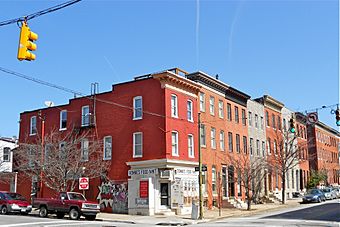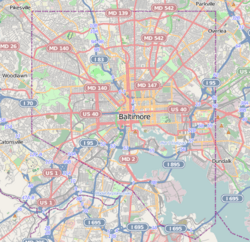Butchers Hill, Baltimore facts for kids
Quick facts for kids |
|
|
Butchers Hill Historic District
|
|

The corner of Chester and Pratt Streets, March 2012
|
|
| Location | Roughly Bounded by Patterson Park Ave., Fayette, Pratt, Chapel, Washington, and Chester Sts., Baltimore, Maryland |
|---|---|
| Area | 57 acres (23 ha) |
| Architectural style | Late Victorian |
| NRHP reference No. | 82001582 |
| Added to NRHP | December 28, 1982 |
Butchers Hill is a neighborhood in Southeast Baltimore, Maryland, United States. It's located near other well-known areas like Fells Point and Patterson Park. This historic neighborhood is known for its unique homes and interesting past.
Before the American Civil War, Butchers Hill was a small village. Many butchers and people who prepared poultry lived here. A lot of them were German American and Jewish American. The homes in Butchers Hill were often bigger than those in nearby Fells Point. Today, part of Butchers Hill is a historic district. This means it's recognized for its important history.
Contents
History of Butchers Hill
Butchers Hill developed differently from most Baltimore neighborhoods. It wasn't built around the harbor or mills. Instead, it started as a separate, successful trading village.
Early Days and Names
People have lived in this area for thousands of years. The first Europeans arrived in the 1600s. In 1667, Quinton Parker claimed 100 acres of land here. Later, John Kemp used it as a farm. Nicholas Rogers bought the land in 1683. He was the first European to live there.
Nicholas's son, William, inherited the land. He started to develop it. By 1803, the neighborhood was called Hampstead Hill. This name came from Hampstead Heath in London, which also has hills. William's son, Benjamin, got into debt. The land was then sold to William Patterson. He was a wealthy Irish American shipping owner.
Patterson never lived in the area himself. But his family helped develop it in the 1800s. Patterson leased land to Jacob Loundenslager. Jacob was a butcher and ran an inn. Until 1835, the area was known as "Loundenslager's Hill."
How Butchers Hill Got Its Name
Over time, more butchers, poultry preparers, and tanners moved in. Many of them were German or Jewish. The city didn't want these businesses in other neighborhoods. This was because of the smells and nature of their work. So, they were kept on the outskirts of the city. Eventually, the neighborhood was renamed for their jobs: Butchers Hill.
Famous Visitors and the Civil War
Frederick Douglass wrote about coming to Baltimore in 1826. He was an 8-year-old enslaved child named Fred Bailey. He arrived by boat and was told to take sheep to Butchers Hill.
During the American Civil War, the area grew. Patterson Park was used by Union soldiers. It had army camps and hospitals. Butchers in the area sold meat to the Union troops. This made them financially successful. One butcher, Jacob J. Blankard, built a large house. It's now called the Blankard-Gunther House.
Growth After the Civil War
Butchers Hill grew a lot after the Civil War. Before, there were separate houses and slaughterhouses. By 1865, these were gone. The area was redeveloped. Homes were built at different times by different people. This gave the neighborhood many unique architectural styles. It wasn't like other areas with long rows of identical houses.
Instead, homes were built in small groups. Butchers Hill also has larger homes. These were built by wealthier residents. Most buildings were constructed between 1850 and 1915.
Changes in the 20th Century
By the mid-1920s, the last butchers had moved away. The neighborhood became home to many immigrants. From the 1920s to the 1940s, Butchers Hill was a busy Jewish neighborhood. It had dentists, doctors, lawyers, and shopkeepers. Synagogues and social clubs were started. The Blankard-Gunther House became a Jewish home for people who needed help. Some homes were changed to include storefronts.
During World War II, the neighborhood faced challenges. Many defense factories were nearby. The population grew quickly. Larger homes were divided into small apartments for workers. After the war, many city dwellers moved to the suburbs. Jewish residents of Butchers Hill largely moved to other parts of Baltimore. Poorer people, especially from Appalachia, moved in.
Revitalization and Today
In the 1970s, efforts were made to improve the neighborhood. These efforts respected Butchers Hill's history. The Butchers Hill Association was formed in the 1970s. In the 1980s, the neighborhood was listed on the National Register of Historic Places.
For a while, people stopped using the name "Butchers Hill." They just called it "East Baltimore." But a real estate effort brought the name "Butchers Hill" back. It is still used today.
Today, Butchers Hill is a lively neighborhood. It's popular with young professionals and artists. Students and staff from Johns Hopkins School of Medicine and Johns Hopkins Hospital also live here. Johns Hopkins employees can even get grants to help buy homes in the area.
People of Butchers Hill
In 2010, about 1,967 people lived in Butchers Hill. The neighborhood is very diverse. About half of the residents were White. About a quarter were African American. There were also Native American, Asian, and other groups. Many people were also Hispanic or Latino.
Butchers Hill is a popular place for students. Many come from the nearby Johns Hopkins medical campus. Most people in the neighborhood have jobs.
The neighborhood is home to many different groups. These include Irish-Americans, Polish-Americans, and Ukrainian-Americans. There are also African-Americans, Lumbee Native Americans, and a growing Hispanic and Latino population.




